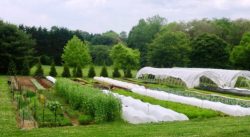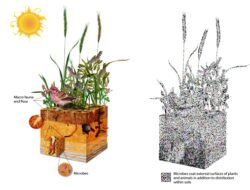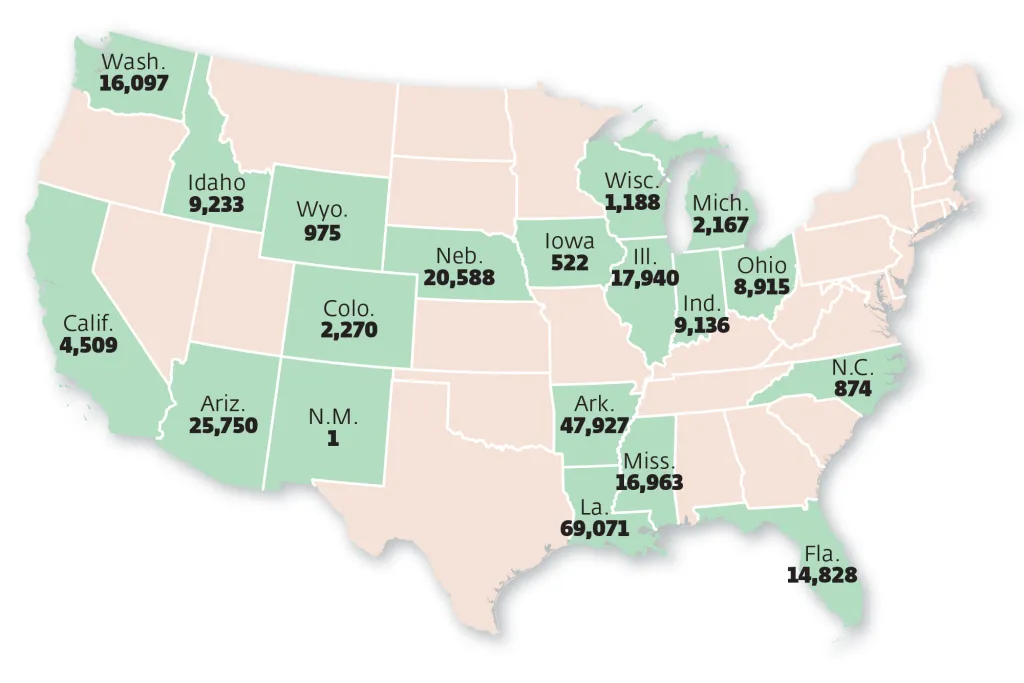Read Time: 5 Minutes Subscribe & Share
Here’s The Not So Bad News
We have all read that farming in the US may reach a crisis point unless we can come up with a large enough new generation of farmers. Fortunately, the USDA offers a measure of reassurance. About two-thirds of farmland in the US is actually owned by individual farmers. That’s a comforting number, and here’s another: Over two million farmland owners are families or individuals. Although we see some nightmarish documentaries and news reports about agricultural monoliths, they number only about 330,000 and occupy a measly 5% of all US farmland.
 According to the US Census, we have at least two million fewer owners of farmland now than we had in 1945. We also have a declining population of actual farmers. Although modern technology certainly has helped in some ways to create more efficient and still sustainable farming, we currently have fewer than three million farmers in the US. Only half that number actually farm all their arable land. About 6% farm part of the land they own and lease out the rest to other small farmers. Forty-four percent of this US Census total do not farm the land but rather lease it out to a variety of tenant farming operations. The growth of individual land ownership since the benchmark of 1945 is good news. This census shows an increase in owners and part owners (with a large increase in part ownership) of farmland and a decrease in tenant farmers.
According to the US Census, we have at least two million fewer owners of farmland now than we had in 1945. We also have a declining population of actual farmers. Although modern technology certainly has helped in some ways to create more efficient and still sustainable farming, we currently have fewer than three million farmers in the US. Only half that number actually farm all their arable land. About 6% farm part of the land they own and lease out the rest to other small farmers. Forty-four percent of this US Census total do not farm the land but rather lease it out to a variety of tenant farming operations. The growth of individual land ownership since the benchmark of 1945 is good news. This census shows an increase in owners and part owners (with a large increase in part ownership) of farmland and a decrease in tenant farmers.
Warning Signs
Our government certainly should monitor the investment of foreign entities purchasing and leasing arable real estate; in addition politicians should also examine the domestic hedge funds and wealthy individuals who are taking farmland away from a small but growing population of younger farmers. Farming needs an infusion of youth. The average age of our current farmers is just shy of 60. And based just on an anecdotal evidence, younger farmers who want to use organic, biodynamic or regenerative agricultural practices have a difficult time finding  land that they can “refurbish” to meet more sustainable and healthier standards for our population. To bring back depleted and chemically saturated farmland requires a series of cover crops that replenish the soil but offer no immediate return on investment. This process can sometimes can take as little as five years, but more often it takes seven years.
land that they can “refurbish” to meet more sustainable and healthier standards for our population. To bring back depleted and chemically saturated farmland requires a series of cover crops that replenish the soil but offer no immediate return on investment. This process can sometimes can take as little as five years, but more often it takes seven years.
While some mainstream and social media focus has highlighted the devastation of the once unbelievably rich farm land in our midwestern states and some legislators are justifiably concerned over domestic farming by foreign entities for their own consumption, there is little oversight of domestic purchases of our arable land for investment. Less than 1/5 of the the United States is suitable for farming. Every acre deserves to be watched over.
 We are not a nation of foragers except for fast food, so arable land is valuable. According to an article in the New York Times, the price of farmland in the US has increased by 75%. in less than two decades. Bill Gates became a brief target of some media attention as both he and his investment company Cascade bought some 269,000 acres of US farmland. Jeff Bezos, your friendly founder of Amazon, recently purchased 400,000 acres of farmland in Texas. Other real estate billionaires have bought thousands of acres in Indiana, Illinois, Iowa and Florida according to Hansen Land Brokers, Inc. Since arable land is finite, and with the increase of land used for home and office building, it is the perfect hedge against the volatility of stock markets worldwide — good protection for some of your billions. Farmland can be profitably leased or sold to the highest bidder. While this may be helpful to your retirement portfolio, it will ultimately affect your grocery bill and the quality of the food you buy.
We are not a nation of foragers except for fast food, so arable land is valuable. According to an article in the New York Times, the price of farmland in the US has increased by 75%. in less than two decades. Bill Gates became a brief target of some media attention as both he and his investment company Cascade bought some 269,000 acres of US farmland. Jeff Bezos, your friendly founder of Amazon, recently purchased 400,000 acres of farmland in Texas. Other real estate billionaires have bought thousands of acres in Indiana, Illinois, Iowa and Florida according to Hansen Land Brokers, Inc. Since arable land is finite, and with the increase of land used for home and office building, it is the perfect hedge against the volatility of stock markets worldwide — good protection for some of your billions. Farmland can be profitably leased or sold to the highest bidder. While this may be helpful to your retirement portfolio, it will ultimately affect your grocery bill and the quality of the food you buy.
A New Crop of Farmers
We have not protected our small farmers. And it is that sector that has historically fed communities, provided superior quality in produce and livestock – and been better stewards of the land. Less known is the necessity of nurturing a broader group of individual farmers. Hidden by the more lurid and dispiriting reporting of political corruption in the US, are the bipartisan efforts both in Congress and at the state level to vastly improve our five year Farm Bill. When I get emails from my representatives in the Senate and Congress, I now pay much more attention to how they vote on these agricultural issues.
When our sharp-penciled editor joined the Arcadia Center for Sustainable Food And Agriculture, we discovered they have a program for military veterans who want to farm commercially. And there are now arising groups of young sustainable farming advocates such as Beginning Farmers or the National Young Farmers Coalition. The first organization is a reference tool for a wide spectrum of people interested in how to farm. From commercial mushroom cultivation to the intricacies of urban farming, this website has an ever changing list of programs, resources and farm employment opportunities.
The National Young Farmers Coalition offers a different face. Established in 2010, they are active in recruiting and aiding immigrant and POC individuals who want to farm but have been denied access and knowledge. Among other invaluable tools, they have developed an online calculator to help aspiring farmers figure out how to purchase land, or lease to own, and use conservation easements to their advantage. All very handy when approaching a loan officer at a bank or filing for a federally funded agricultural grant. This coalition is organizing on several political and social fronts. Since the Climate Crisis is no longer looming but has arrived, dealing with and mitigating it is certainly a guiding focus. They argue that farming and feeding the US population is a public service, as well as means of earning an income. And they advocate very strongly for social change both in the agricultural trades and in financial markets.
recruiting and aiding immigrant and POC individuals who want to farm but have been denied access and knowledge. Among other invaluable tools, they have developed an online calculator to help aspiring farmers figure out how to purchase land, or lease to own, and use conservation easements to their advantage. All very handy when approaching a loan officer at a bank or filing for a federally funded agricultural grant. This coalition is organizing on several political and social fronts. Since the Climate Crisis is no longer looming but has arrived, dealing with and mitigating it is certainly a guiding focus. They argue that farming and feeding the US population is a public service, as well as means of earning an income. And they advocate very strongly for social change both in the agricultural trades and in financial markets.
Even with all the depressing statistics, we should be encouraged to see these signs of farmland advocacy taking root. We consumers need to help nurture these seeds so that our children and grandchildren can reap a more bountiful harvest.

Kitchen Detail shares under the radar recipes, explores the art of cooking, the stories behind food, and the tools that bring it all together, while uncovering the social, political, and environmental truths that shape our culinary world.




Great article, except increased CO2 means more plant food. The IPCC’s 2 deg F increase in temperature over the last 140 years has not, according to the IPCC, increased droughts, floods, and tropical storms. It is warmer, of course, but that decreases mortality compared to colder weather. The alleged crisis is still in the future. Same for sea level, which is rising about 1.7 mm annually and has been for at least 100 years.
The author of the above comment wants KD readers to know that his information comes from http://www.climate4you.com. He feels that this website offers the most data. It is the personal website of a geomorphology professor in Oslo, Norway, who selects and aggregates strands of scientific data to validate his views on climate change.
Excellent and encouraging information. Although I’m too old to entertain the idea of helping local farmers, I’ll find out how I can contribute my time to participate in farming advocacy to insure that this issue resonates within my community.
Hello Joan,
I am very happy that this post has moved you to becoming an advocate for our next generation of farmers! Those two websites were both fascinating to delve into.